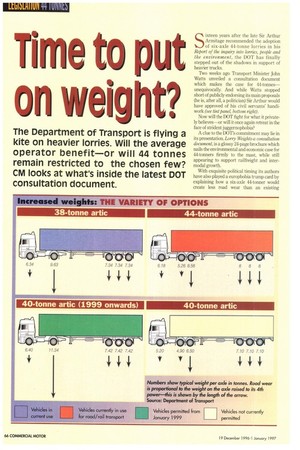Time to put on weight.
Page 68

Page 69

If you've noticed an error in this article please click here to report it so we can fix it.
The Department of Transport is flying a kite on heavier lorries. Will the average operator benefit—or will 44 tonnes remain restricted to the chosen few? CM looks at what's inside the latest DOT consultation document.
Sixteen years after the late Sir Arthur Armitage recommended the adoption of six-axle 44-tonne lorries in his Report of the inquiry into lorries, people and the environment, the DOT has finally stepped out of the shadows in support of heavier trucks.
Two weeks ago Transport Minister John Watts unveiled a consultation document which makes the case for 44-tonnesunequivocally. And while Watts stopped short of publicly endorsing its main proposals (he is, after all, a politician) Sir Arthur would have approved of his civil servants' handiwork (see tint panel, bottom right).
Now will the DOT fight for what it privately believes—or will it once again retreat in the face of strident juggernophobia?
A clue to the DOT's commitment may lie in its presentation. Lorry Weights-a consultation document, is a glossy 24-page brochure which nails the environmental and economic case for 44-tanners firmly to the mast, while still appearing to support railfreight and intermodal growth.
With exquisite political timing its authors have also played a europhobia trump card by explaining how a six-axle 44-tonner would create less road wear than an existing
38-tonner, before declaring: "But the obligation to accept "EC" 40-tonne/five-axle/11.5tonne drive axle vehicles from 1 January 1999 will increase road wear and have significant implications for many bridges."
And in a breathtaking display of chutzpah, it adds: "Many movers of heavy goods have indicated that the incentive of the extra payload offered by 44 tonnes would encourage them to re-equip with less polluting Euro-2 vehicles more rapidly than would otherwise be the case." Oh really?
Such glowing endorsements cannot hide the fact that the gap between the DOT's thinking and that of its political masters is still wide. How wide was underlined last year when Transport Minister Robert Key appeared before the House of Lords Select Committee on the European Communities on the maximum weights and dimensions of road vehicles.
Asked what the effect of adopting 44 tonnes on general haulage would be. Key warned: "Although there may be a small percentage saving in the number of heavy lorries on our roads, rail would lose a great deal."
His words illustrate how hard it's been for the Government to turn its rhetorical promises to put more freight back on to the rails into reality. Mindful of those promises Transport Secretary Sir George Young may yet decide to restrict any increase to piggyback operations and trucks carrying containers to and from sea ports.
The rail lobby has already issued dire warnings in defence of the status quo. According to Ian Braybrook, managing director of English Welsh & Scottish Railways, the new private railway company running the majority of Britain's railfreight "The (unrestricted) introduction of 44-tonne lorries will significantly alter the relative competitive positions of the two modes and be extremely damaging to the prospects of freight by rail."
However, Braybrook is jumping the gun. Even if 44 tonnes were to be granted for general haulage the DOT is suggesting it happens "...no earlier than 1 January 1999 or possibly as late as 2001".
But by far the most intriguing aspect of the consultation document is the proposal to allow six-axle artics at 40 tonnes generally "...as soon as regulations can be brought into force", The DOT defends them as being less road-wearing and therefore more desirable than the EC's "harmonised" five-axle outfit with an 11.5-tonne drive axle running at an identical weight the very vehicle the UK sought a derogation from until 1999.
Clearly, if a 3+3 40-tormer were to be adopted universally it would be but a short step to go to 44 tonnes, as and when it was politically safe to do so.
However, the whole consultative process could yet be sidelined by an early election next year. If Labour wins there's no guarantee it will be any more supportive of heavier lorries than the Tories. In the end, the DOT's best shot for years may yet miss the target.
El by Brian Weatherley








































































































































